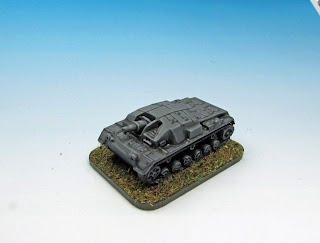AS I mentioned in my first post, I've been tinkering with some homebrew rules for my WWII project. They are based on a set I had originally started writing for WWI gaming back in early 2015, but by the end of that year had been pressed into service for the Falklands War! Now they have been converted again, this time for WWII, and are almost finished. I had a number of criteria when I started writing them and these were that they (1) would be company-level, with one infantry base representing a section and support weapon/AFV bases at 1:1, (2) would be built around each side generating a random amount of commands per turn, (3) would amalgamate most weapons into broad groups or "types", (4) would treat infantry and armour similarly, (5) would merge damage and morale and make them cumulative like "wounds", and, lastly (6), that all this would fit comfortably onto no more than four A4 sheets. Rather a tall order of myself, I know, but I am pleased to relay that all these principles have been met and tentatively reside under the snappy title of Forward Command (or "ForC" for short).
I feel I must point out that although the core rules are indeed contained over four pages, there will be separate "army lists" for nations/periods/theatres. As it is the period that currently most interests me, I am presently drawing up lists for Europe 1939-40 with the following nations to be covered: Germany, Poland, Denmark, Norway, Holland, Belgium, France, and Britain (no Luxembourg, sorry!). In fact I would say that this latter task is proving rather more demanding than designing and writing the rules themselves! To give curious readers a inkling of what I am up to, I include below the Dutch Army List as it currently stands, although no doubt this will be subject to revision before the end. As previously stated, despite the fact that I am writing them primarily for myself, when the rules and lists are ready I shall make them freely available via this blog.
As you might appreciate, the last month has seen heavy play-testing and revision - including a complete overhaul of the aforementioned AFV rules so that they harmonise with the infantry rules more-or-less completely. So that this post isn't solely comprised of my febrile wittering, I have included some quick pictures of these play-test games to showcase the scenery I have been building. As can be seen I still have some way to go in this department, although I hope to add mastic roads and rivers in the coming weeks. However, there are also lots of miniatures and buildings to be painted too, so we shall see about that. Have good weekend readers.










Addendum. Moments after I posted this piece the following book was delivered. At some 650 pages it is a hefty (and somewhat pricey) tome, but is more than worth it for the plethora of rare photos with which every page is adorned. I can foresee much of the weekend spent in a comfy armchair with Jean-Paul Pallud's Blitzkrieg in the West in my hands and Chopin's Nocturnes on the stereo, courtesy of Vladimir Ashkenazy!














































